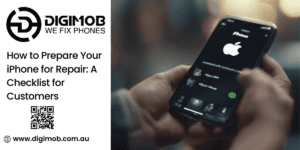Our mobile devices are an integral part of our daily lives, serving multiple purposes beyond communication. They function as cameras, GPS devices, multimedia players, and so much more, which is why keeping them safe and damage-free is of utmost importance. As the leading mobile phone repair centre in South Australia, Adelaide, Digimob Phone Repairs understands the significant investment we place in our smartphones and the need to protect them from potential hazards.
In this comprehensive guide, we’ll share expert advice and practical tips on safeguarding your mobile device from damage and loss, helping you ensure the longevity, value, and performance of your smartphone. From protective accessories and safe handling practices to securing your device against theft, we will delve into an array of strategies to keep your mobile phone in optimal condition and reduce the need for costly repairs or replacements.
Having a strong understanding of how to protect and maintain your smartphone is essential, as even with access to top mobile phone repair services like Digimob Phone Repairs, prevention is always better than cure. Equip yourself with the knowledge and tools necessary to care for your device and minimise the risk of damage or loss with our insightful guide, giving you peace of mind in knowing that your mobile investment is well-protected and ready to serve you for years to come.
1. Investing in High-Quality Protective Accessories
One of the most effective ways to protect your mobile device from damage is to invest in high-quality protective accessories. These can help minimise the impact of accidental drops, scrapes, or bumps and keep your device looking and functioning like new:
- Durable cases: A good-quality case can provide excellent protection from potential damage due to falls and daily wear and tear. Look for shock-absorbing materials, raised edges that protect camera lenses and screens, and precise cut-outs to maintain accessibility to ports and buttons.
- Screen protectors: A screen protector can prevent scratches, cracks, and other display damage. Tempered glass screen protectors are generally the best choice for durability and protection, while also maintaining optimal touch sensitivity.
- Water-resistant pouches: If you frequently encounter water-based activities or environments, consider a water-resistant pouch to keep your mobile device safe and dry.
2. Safe Handling Practices and Establishing Routines
Alongside investing in protective accessories, adopting safe handling practices and routines for your mobile device can further reduce the risk of damage and loss:
- Device storage: Get into a routine of placing your device in a fixed location when not in use, such as a designated pocket in your bag or a secure spot in your home or office. This minimises the risk of misplacing your mobile phone or causing accidental damage by sitting or stepping on it.
- Don’t leave devices unattended: Always keep your mobile device within sight when in public spaces to avoid theft or loss. Never leave your phone unattended on a table or counter, as it can attract opportunistic thieves.
- Using lanyards or wrist straps: For those with a higher risk of dropping their phone or losing grip during outdoor activities, attaching a lanyard or wrist strap to your device can provide extra peace of mind and security.
3. Securing Your Device Against Theft
In addition to protecting your mobile device from physical damage, it’s crucial to take measures to safeguard against loss or theft:
- Use a password, PIN, or biometric security feature: Passwords, PIN codes, and biometric security options like fingerprint or facial recognition can help prevent unauthorised access to your mobile device and deter potential thieves.
- Enable the ‘Find My Device’ feature: Most smartphones have built-in tracking features, such as ‘Find My iPhone’ for iOS devices and ‘Find My Device’ for Android. These services can help you locate a lost or stolen device and remotely lock or erase data if needed.
- Be cautious with public Wi-Fi networks: Avoid connecting to unsecured public Wi-Fi networks, as they can expose your device to various risks like hacking or theft of personal data.
4. Preparing for Worst-Case Scenarios
While prevention is key, it’s also important to prepare for the possibility of damage or theft occurring. Here are some steps you can take to minimise the impact should something go wrong:
- Regularly back up your mobile data: Backing up your device’s data to the cloud or another storage location helps ensure that your photos, contacts, and important information are safe and easily recoverable.
- Record your device’s information: Make note of your phone’s make, model, and IMEI (International Mobile Equipment Identity) number. This information can help identify your device if it needs to be recovered or reported as stolen.
- Keep important information off your device: If possible, avoid storing highly sensitive personal information, such as bank account or credit card details, directly on your mobile device.
Trust Digimob Phone Repairs to Safeguard and Repair Your Mobile Device
Protecting your mobile device entails a combination of investing in quality accessories, practising safe handling habits, and taking security measures against theft. By implementing these strategies, you can significantly reduce the chances of damage or loss occurring to your smartphone.
Should the need arise, trust Digimob Phone Repairs as the leading mobile phone repair centre in South Australia, Adelaide. Our expert team is here to help repair and maintain a wide range of mobile device issues resulting from accidents or unexpected events. Contact us today to benefit from our wide array of services, knowing your mobile phone is in trusted and experienced hands.


